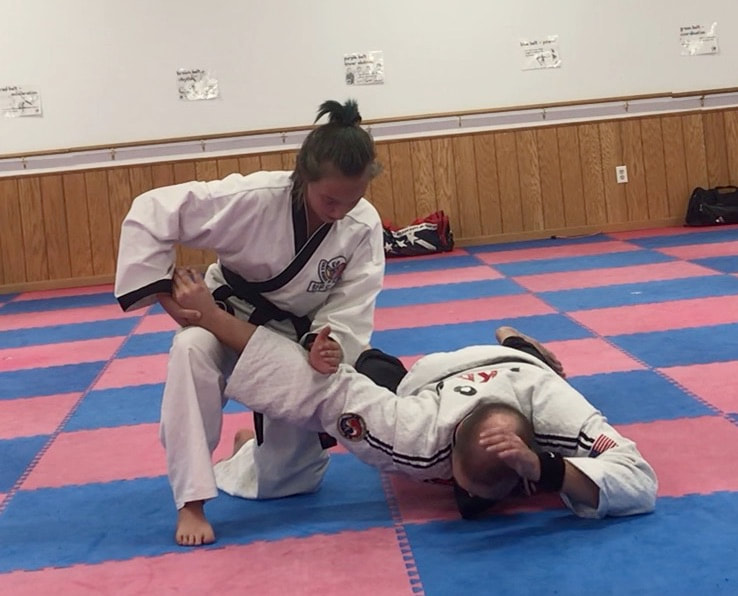HAPKIDO

Hapkido is a soft-style martial art which integrates joint locks, pressure points, kicks and strikes for a complete system of self-defense:
- Hap - Coordination
- Ki - Power
- Do - The way of
Hapkido is "the way of coordinated power.” Unlike most martial arts, Hapkido is strictly defensive. Most techniques learned in Hapkido redirect an attacker’s force instead of meeting it head on by incorporating three main principles:
The water principle is so-called because hapkido is "soft", as it will find the easiest way around any obstacle, much like water. Hapkido helps instill confidence, disciple, respect, honor and perseverance. Having access to a location like HMD Academy in Savoy allows a safe and controlled area. Plenty of room, full coverage of mats, and equipment makes it very easy teach new students the importance of falling without incurring injuries.
- Hap - Coordination
- Ki - Power
- Do - The way of
Hapkido is "the way of coordinated power.” Unlike most martial arts, Hapkido is strictly defensive. Most techniques learned in Hapkido redirect an attacker’s force instead of meeting it head on by incorporating three main principles:
- Non or least resistance.
- Circular motion.
- The water principle.
- Nonresistance means remaining relaxed and not opposing an attacker's strength directly. Circular motion is the redirection of an attack's power into a circular pattern, allowing the defender to use it to his or her own advantage.
The water principle is so-called because hapkido is "soft", as it will find the easiest way around any obstacle, much like water. Hapkido helps instill confidence, disciple, respect, honor and perseverance. Having access to a location like HMD Academy in Savoy allows a safe and controlled area. Plenty of room, full coverage of mats, and equipment makes it very easy teach new students the importance of falling without incurring injuries.
Hapkido is a Korean martial art that addresses both the hard and soft side of martial arts and self defense. Hapkido uses both high and low kicks, striking with hands, and using the 3 principles of Hapkido to takedown or throw an opponent who is in close range and grabbing.

The 3 Principles of Hapkido
- Hwa (Non resistance) - Not meeting force with force. When a close range opponent attacks, instead of attempting to abruptly stop the attack, move the same direction of the force being applied. (Example: Attacker reaches and grabs wrist. Instead of pushing back, grab and pull the attackers arm drawing the attackers shoulders forward and off balance. Even for larger attackers once balance is broken it is easier for smaller defenders to perform the simple techniques to draw the attacker to the ground.
- Won (Circular motion) - Using the momentum of a circle to lock an attackers joint or add power to throw the attacker to the ground. Circular motion can be applied in many ways. When a persons joint wether it’s a wrist, elbow, or neck (facet joints) can only rotate so far. When the joint reaches the limit of rotation the rest of the body reacts. Sometimes in pain causing compliance, and sometimes pain causing the body to move to off balance and take down to the ground. When applying submissions a circular motion is applied. Like a Tetter Totter on a school playground. Using a focal point can produce leverage to hyper extend a joint or control the attacker pinning them on the ground. Example below: by applying downward pressure on the elbow of the attacker and pulling up on the attackers wrist not only hyperextends the attackers elbow joint but causes leverage to hold down the attacker on the ground if they attempt to stand up. Circular motion should be applied the majority of the time like the taegeuk circle of the Korean flag. As one motion (Blue) is going upward the other motion (Red) is going down. Both motions never meet but move opposite of each other.
- Yu (The Water Principle) - One famous explanation of the water principle is to picture a rock in stream. The flowing water that splashes at the face of the rock has little effect to move the rock. The water that is flowing around the rock sweeping the stream bed of sand or dirt out from under neath the rock actually moves the rock. As this is applied in Hapkido when you have a larger or stronger attacker staying in front of the attacker can leave you exposed and over powered. Using angles and movement to flow around the attacker to attack the attackers exposed back. The water principle can also be thought of as being relaxed as possible and if in the possibility of a technique failing being able to flow into another technique, constantly moving and never stopping your flow until the attacker is off balance, controlled, or opens the chance of escape.
hapkido training videos
|
|
|























